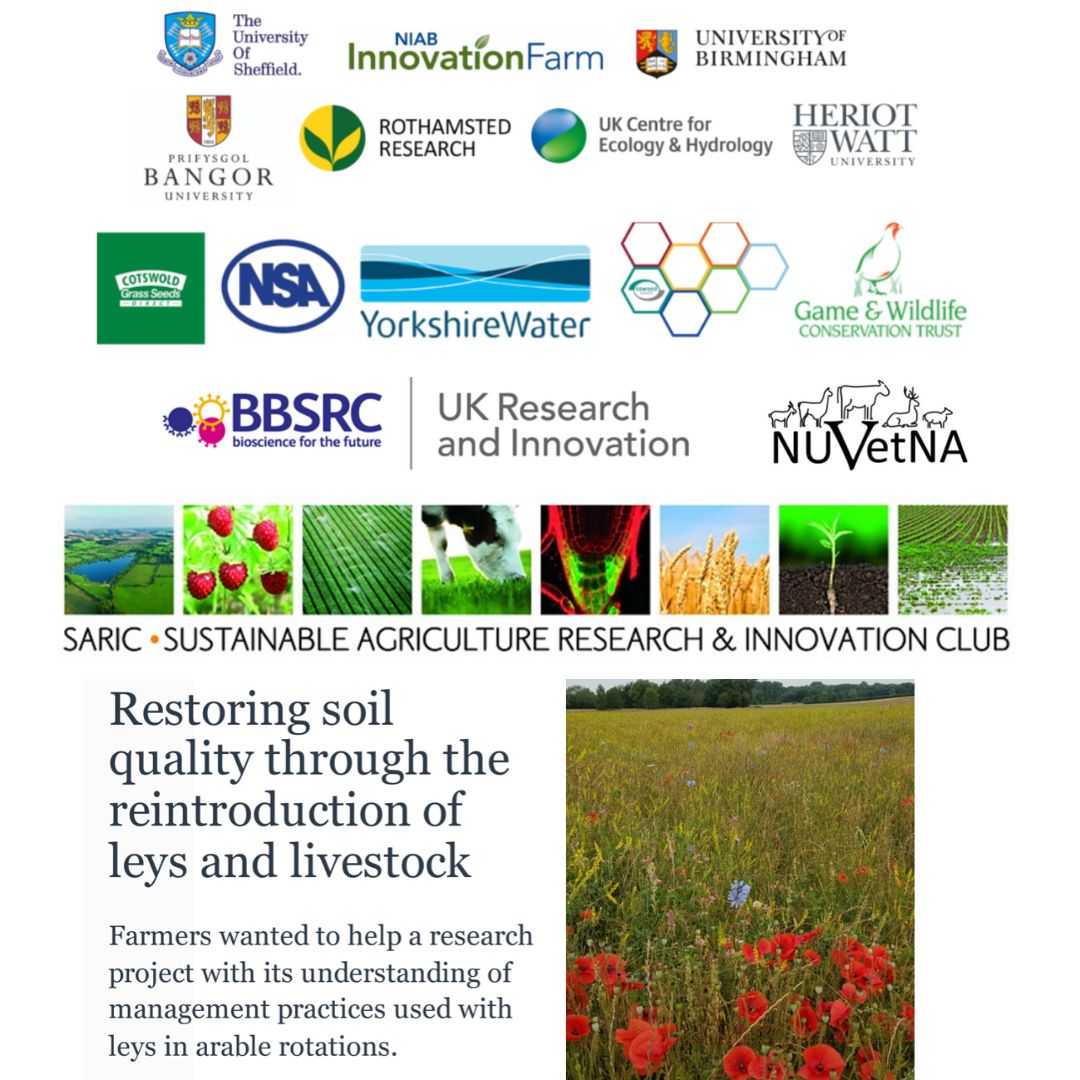SARIC - Sustainable Agriculture Research & Innovation Club


Farmers wanted to help a research project with its understanding of management practices used with leys in arable rotation.
Our research
Soil degradation is a key threat facing UK agriculture, estimated to cost England and Wales alone between £0.9 to 1.4 billion annually1. Loss of soil organic matter, increased soil compaction and erosion from continuous arable cropping and agri-chemical use is a key contributor to this. To alleviate this, attention is rapidly turning to the reintroduction of leys (temporary grasslands lasting 1-4 years) and livestock in crop rotations to restore soil quality.
In the UK, herbal leys are gaining in popularity due to their promotion in agri-environment schemes and ability to deliver greater ecosystem services than their conventional counterparts. Herbal leys, also known as multispecies leys or diverse swards, often contain a mixture of deep-rooting grasses (e.g., Dactylis glomerata), legumes (e.g., Medicago sativa) and herbs (e.g., Cichorium intybus) which can improve the soil structure and access subsoil water and nutrients unavailable to a conventional grass or grass-clover ley. Plants selected for the herbal ley mixture can offer a potential greenhouse gas mitigation strategy through reducing nitrogen lost in urine and dung and improving livestock productivity. Herbal leys were compared against a conventional grass-clover mix in this research project.
Our multidisciplinary research team from the Universities of Sheffield, Bangor, Birmingham, Herriot Watt and institutions such as NIAB, Rothamsted Research and UK-CEH have been investigating whether a herbal ley can provide greater environmental and economic benefits than a grass-clover ley, managed either by grazing with sheep or mowing. The project, now in its final year, has split-field experimental sites on arable land in eastern England and a grassland field site in North Wales.
As the project enters its last phase, we want to develop a better understanding of how farmers perceive the use of livestock on typically arable land, how leys are used in crop rotations, what management methods are used, and any issues that arise when leys are returned to an arable crop.
1 Graves et al. (2015) https://doi.org/10.1016/j.ecolecon.2015.07.026
Our key findings so far:
Soil quality:
- Large taproots (e.g. from Cichorium intybus) improved soil structure under the herbal ley.
- Leys suffered from areas of compaction and erosion from sheep movement.
Yield:
- On heavier soils, ploughing and sowing leys rather than direct drilling achieved higher yields.
- Crops following leys required half the nitrogen fertiliser than the control.
- Weeds (e.g., Festulolium) from the leys were an issue in the direct drilled crops.
Animal health:
- No major impact on gastrointestinal parasites in sheep grazing either diet.
- Herbal ley grazed lambs had a greater liveweight gain than those on the grass-clover diet.
- Improved health in herbal ley grazed lambs with higher levels of plasma selenium and cobalt.
What do farmers think about having livestock on arable land?
Over the past year, we ran a short study (workshop and questionnaire) to understand what farmers perceive to be the barriers and opportunities to having livestock (particularly sheep) on their arable land. The results of our workshops with farmers, researchers, and industry bodies (including the National Sheep Association, ADAS, and the Soil Association) uncovered four key results:
- The extent and locations of leys in crop rotations is not well captured in DEFRA data.
- Large arable farmers with some grass and access to livestock (and not just mixed farmers) are including leys and livestock in their rotations.
- Improving soil health, reducing black-grass risk, increasing drought tolerance, and improving policy support were listed as reasons for adoption.
- Connecting livestock and arable farmers to encourage them to share equipment and expertise and information on the costs and benefits of livestock in arable rotations could encourage a wider uptake of the practice.
We also asked 70 farmers what they would need to encourage them to incorporate sheep into their arable rotations. We found that many farmers were already doing it! In addition, a high proportion of farmers would consider it if it was made easier or incentivised, whilst some farmers would never consider having livestock (see graph).
So what research gaps do we have now?
We would like to know more about how farmers manage their ley after grazing has finished. This is where we hope you can help!
Can you help with our survey?
We need to know how farmers manage their ley when returning it to an arable crop. Do you plough it? Direct drill? Use herbicides? Let us know! Our online survey takes between 5-15 minutes and will ask you about your farm, how you manage the ley (e.g. by mowing or grazing), and how you return it to an arable crop and if you run into any issues post-ley (e.g. weeds). Your responses will help us target areas of interest for future research and provide a highly valuable insight to policy makers on how farmers are managing their fields to help inform future policy.
The survey is open until the 1st of September 2022 and can be found online here:
https://ceh-online-surveys.onlinesurveys.ac.uk/reversion_of_leys_to_arable
Find out more about our research!
Visit our project website here: http://restoringsoilquality.bangor.ac.uk/
Keep an eye on social media updates from members of the team: @InnovationFarm1 and @EmilyCooledge.
Funding provided by the UK Biotechnology and Biological Sciences Research Council under the Sustainable Agriculture Research and Innovation Club (SARIC) programme (BB/R021716/1).
Author: SARIC
Date Posted: 28th July 2022



